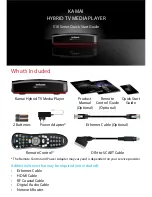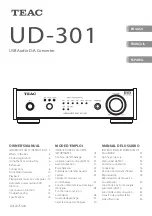
LED Indicators
McPC TP/FO features four diagnostic LEDs. They are:
FFO
O RRC
CVV
Blinks yellow when fiber port is receiving data.
TTPP LLN
NKK
Glows green when a twisted pair link is established.
FFAA
Glows green when FiberAlert is enabled.
FFO
O LLN
NKK
Glows green when a fiber link is established.
McPC TP/BNC also features four diagnostic LEDs. They are:
TTPP RRC
CVV
Blinks yellow when twisted pair port is receiving data.
TTPP LLN
NKK
Glows green when a twisted pair link is established.
BBN
NC
C C
CO
O
Blinks red in normal operation indicating normal
collisions are being detected on the BNC segment.
BBN
NC
C RRC
CVV
Blinks yellow when BNC port is receiving data.
General Information
T
E C H N I C A L
S
U P P O R T
TEL:
(949) 465-3000; (800) 624-1070 (in U.S. and Canada);
+32-16-550880 (Europe)
FAX:
(949) 465-3020
E-MAIL:
WEB:
w w w . i m c n e t w o r k s . c o m
S
P E C I F I C A T I O N S
Environmental
Operating Temperature: 32° - 104° F (0° - 40° C)
Storage Temperature: 22° - 160° F (-6° - 71° C)
Humidity: 5 - 95% (non-condensing)
Power
Input Load: 5VDC +/- 5%, 0.7A max
Fiber Optic Power
For fiber optic power budgets, visit the IMC Networks Web site at
www.imcnetworks.com/fopower.htm
.
E
L E C T R O S T A T I C
D
I S C H A R G E
P
R E C A U T I O N S
Electrostatic discharge (ESD) can cause damage to your add-in modules. Always
observe the following precautions when installing or handling an add-in module or any
board assembly.
1)
Do not remove unit from its protective packaging until you are ready to install it.
2)
Wear an ESD wrist grounding strap before handling any module or component. If
you do not have a wrist strap, maintain grounded contact with the system unit
throughout any procedure requiring ESD protection.
6
If a media converter is not receiving a fiber link, LinkLoss disables the trans-
mitter on the media converter's twisted pair port. This results in a loss of link
on the remote twisted pair device.
E
N A B L I N G A N D
U
S I N G
F
I B E R
A
L E R T A N D
L
I N K
L
O S S
FiberAlert and LinkLoss are configured on McPC TP/FO by adjusting the
two-position switches located on the faceplate, next to the fiber connectors.
The switch for LinkLoss is labeled “LL.” The switch for FiberAlert is labeled
“FA.”
Enable LinkLoss or FiberAlert by moving the corresponding switch to the up
(ON) position. Disable either (default) by moving the switch to the down
(OFF) position.
In a central site to remote site media conversion, IMC Networks recom-
mends you enable your McPC TP/FOs’ troubleshooting features as follows:
FiberAlert:
Remote site only
LinkLoss:
Central and remote site
This will ensure that most faults can be detected by an administrator locat-
ed at the central site, no matter where they occur on the network.
If you are unsure of how best to implement these features in your configu-
ration, please contact IMC Networks technical support at (800) 624-1070
(U.S. and Canada), +32-16-550880 (Europe), or send an e-mail to
tteecchhssuuppppoorrtt@
@iim
mccnneettw
woorrkkss..ccoom
m
.
Installation Troubleshooting
➤
During installation, first test your connections with all troubleshooting
features disabled. Then enable these features, if desired, just before
final installation. This will reduce the features’ interference with test-
ing.
➤
To test McPC TP/FO by itself, you must have an appropriate fiber patch
cable. First, connect McPC TP/FO to the twisted pair device with a
twisted pair cable. Next, loop a single strand of fiber from the transmit
port to the receive port of your media converter. Finally, verify that
you have both twisted pair and fiber link on your media converter.
➤
Make sure that you are using the appropriate twisted pair cable
or have the crossover/pass-through button on the media converter set
correctly.
5






















